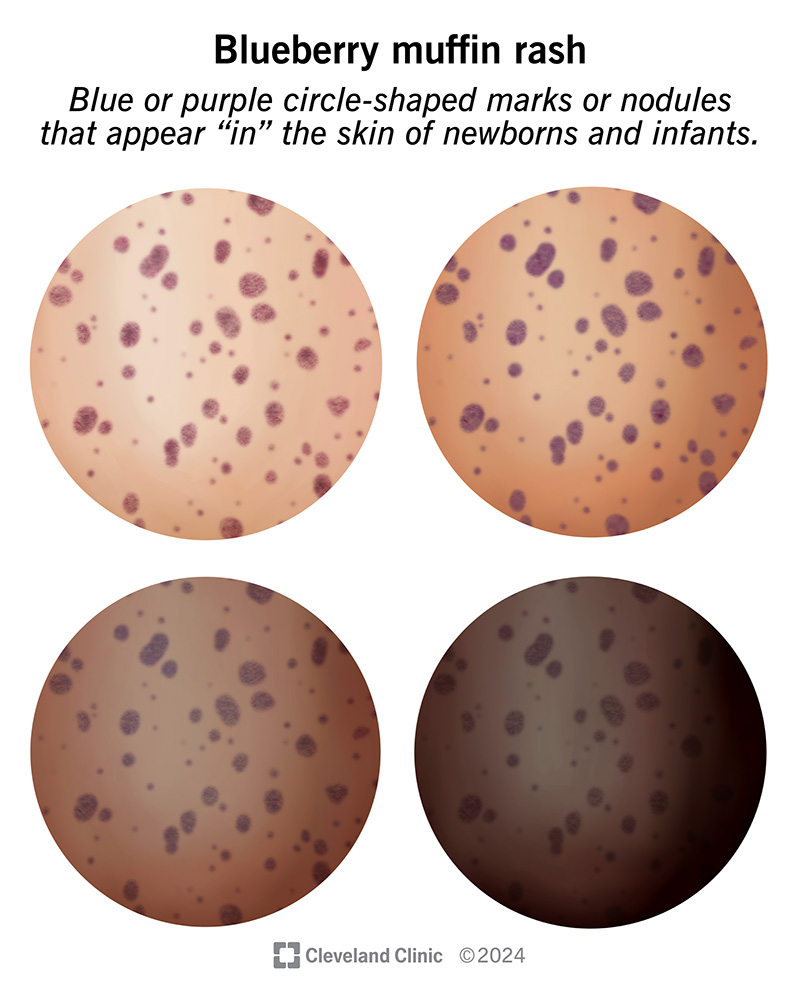Blueberry muffin rash is a sign that your baby needs medical help. It involves blue or purple marks or bumps in their skin that are usually widespread. The rash has several possible causes, including infections, cancers and tumors, and certain blood disorders.
Advertisement
Cleveland Clinic is a non-profit academic medical center. Advertising on our site helps support our mission. We do not endorse non-Cleveland Clinic products or services. Policy

A blueberry muffin rash can affect newborns and infants. It’s blue or purple and looks like multiple circle-shaped marks or raised bumps (nodules) in their skin. The rash appears to be “in” their skin rather than on top of their skin.
Advertisement
Cleveland Clinic is a non-profit academic medical center. Advertising on our site helps support our mission. We do not endorse non-Cleveland Clinic products or services. Policy
These marks happen due to:
Several conditions can cause each of these three issues — most of them are rare. Your baby will likely have other symptoms as well. A blueberry muffin rash is a sign that your baby needs medical attention. It won’t go away on its own.
Other names for blueberry muffin rash include:
A blueberry muffin rash can have several possible causes, including:
TORCH infections (or TORCH syndrome) are a group of infectious diseases that affect a fetus or newborn baby. If you get a TORCH infection, you can pass it to your baby during pregnancy, during delivery or after birth.
TORCH is an acronym for a group of infections, including:
Symptoms of TORCH infections include:
Advertisement
Since you can pass TORCH infections to the fetus or baby, it’s important to see a healthcare provider regularly while you’re pregnant. Your provider will do blood tests to check for certain infections.
They’ll also order blood tests to see if you have immunity to infections. For example, if a test reveals that you’re immune to rubella during pregnancy, it’s much less likely to pass to the fetus or baby.
Tumors and cancers that can cause a blueberry muffin rash in infants include:
Other symptoms of these conditions include:
Extramedullary hematopoiesis happens when abnormal blood cell production happens outside your bone marrow. Extramedullary means “outside of the bone marrow.” Hematopoiesis means “blood cell production.”
Extramedullary hematopoiesis causes that can result in a blueberry muffin rash include:
Other symptoms of these conditions may include:
Your baby’s healthcare provider will do a physical exam and assess your baby for other symptoms. They may recommend a variety of tests to diagnose the underlying cause, including:
If providers suspect a TORCH infection is the cause, they may recommend screening tests for the birth mother, as well.
The treatment for blueberry muffin rash involves treating the underlying cause.
For example, treatment for TORCH infections may include antibiotics, antiparasitics or antiviral medications. Treatment for neuroblastoma may include surgery, chemotherapy, immunotherapy and/or radiation therapy.
Advertisement
Your baby’s healthcare team will go over their treatment plan with you. Don’t hesitate to ask questions or raise any concerns.
If your baby has a blueberry muffin rash, it’s important to get them professional medical help right away. Go to the emergency room or alert your baby’s healthcare provider if they’re already in the hospital.
Although it’s rare, a blueberry muffin rash is a sign that something isn’t working as it should in your baby’s body. While this can be alarming, know that their healthcare team will get to the bottom of the cause and offer a thorough treatment plan for your baby. Thorough prenatal care can help catch or prevent TORCH infections that can lead to blueberry muffin rash.
Advertisement
Whether you need stitches, a broken bone set or think your appendix might be causing your abdominal pain, Cleveland Clinic’s emergency medicine team is here to help.

Last reviewed on 04/09/2024.
Learn more about the Health Library and our editorial process.